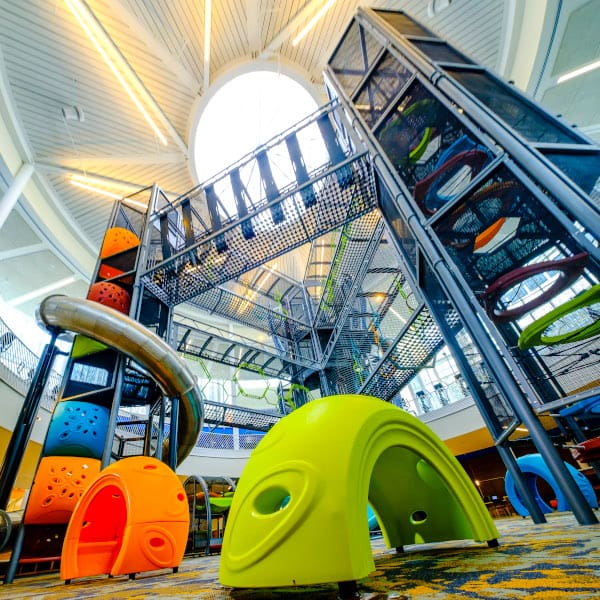Playing it Safe

Playing it Safe
200,000—that’s how many children are injured in playground-related incidents each year in the US. This staggering figure is a reminder that playground activity can be rough, and kids aren’t always very careful. Most of these injuries are the result of falls, or contact with hard surfaces, which is why Soft Play puts so much effort into designing soft, safe play areas to mitigate the number one cause of playground injury. Safety should be a top priority in any play scenario, which is why Soft Play makes safety a primary design element in every one of their play areas. In fact, this is such a priority for the company that Soft Play strives to exceed all compliance rules and regulations for play equipment. Let’s take a closer look at how they incorporate safety into every one of their designs.
Safety is built into every aspect of the Soft Play experience, starting with the basic design concept, as well as in manufacturing and installation. The materials used are soft, fire-resistant, and anti-bacterial in order to offer the utmost protection. Play equipment such as climbers, slides, tunnels, as well as safety flooring meet all product requirements and safety ratings of the appropriate ASTM Safety Standards (ASTM F-1487 – Standard Consumer Safety Performance Specifications for Playground Equipment for Public Use, ASTM F-1918 – Standard Consumer Safety Performance Specifications for Soft Contained Play Equipment, and ASTM F-1148 – Standard Consumer Safety Performance Specifications for Home Playground Equipment. Soft Play meets or exceeds several other benchmarks for safety set by The American Society for Testing and Materials (ASTM), as well as the CPSIA – Consumer Products Safety Improvement Act, a congressional safety act enacted in 2008. Demonstrating their absolute commitment to safety, Soft Play has also completed many third-party tests to ensure compliance with various applicable flame and fire test ratings. Soft Play has six Certified Playground Safety Inspectors (CPSI) on staff, and these professionals inspect and certify each Soft Play play area to ensure ASTM as well as ADA compliancy. These CPSIs receive the most comprehensive and up-to-date training possible and are some of the most knowledgeable professionals when it comes to play space safety issues such as hazard identification, equipment specifications, surfacing requirements, and risk management methods.
Soft Play’s equipment has a number of important design elements to promote child safety. For starters, it is designed with safety zones in mind. These rings of clearance help to ensure that collisions between children, play equipment, and other hard objects can be avoided. The play equipment itself is also designed to kid friendly dimensions to avoid injury, and the materials used are created to be soft and anti-bacterial. Since falls are the number one source of playground injury, Soft Play’s DuraSoft Safety Flooring System is a 1.5” thick material rated at a 5’ critical fall height, and their Poured-In-Place Safety Surfacing is 2” thick and rated at 5’ critical Fall Height, under ASTM F1292. Both products meet all ASTM F-1951 ADA accessibility requirements.
The importance of space is a key design feature that Soft Play considers in a number of different ways when designing all their play equipment. All areas are also designed to blend with the aesthetics of their surroundings, so as not to disrupt the spaces they are placed in. Play areas are also generally enclosed, with no more than two access points to make sure that kids stay where parents can see them.
Regarding space, play areas are ideally at least 200 sq. ft. for maximum fun and safety, with designers allotting one child per 8 square feet of play area. Use zones are the rings of clearance around play equipment that make play areas safer by putting space between kids and play area hazards. The widest zone for Soft Foam play requires play elements to maintain a 44” clearance from any hard objects like walls or flooring. After that, all play elements require a 36” clearance from other stationary play equipment. The only exception is if the equipment is 12” or less in height. Such items that are functionally linked, can be between 6” to 12” apart. Finally, play elements may be located up to 6” away from padded walls or the framework of a play structure. These rings of safety help to ensure that collisions between children, play equipment, and other hard objects are less likely to occur.
The play equipment itself is also designed to kid-friendly dimensions in order to avoid injury, and the materials used are specially created to be soft and even anti-bacterial. In fact, Soft Play’s soft foam element coatings are ASTM (G21 and E2180) certified antibacterial. The powerful anti-bacterial coatings were recently tested by an independent third party testing laboratory who concluded that the coatings killed bacteria and reduced fungi (mold) that came in contact with it.
All this effort to create a safe play experience is for good reason. Studies by both the CDC and the CPSC show that each year more than 200,00 children under 14 are treated for injuries caused in playground-related incidents, most of which come from falls or impacts with hard surfaces. Soft Play’s flooring and soft foam equipment are designed for safety first and foremost, in order to protect against fall-related injury and sickness. Parents will appreciate the extensive research and testing that went into the play areas, with their impact ratings and anti-bacterial coatings, while kids will love the soft foam equipment and flooring that feels like a tumbling mat. These safety features make kids feel powerful and at ease because they can do things that conventional play equipment does not allow them to, while their parents can rest easy knowing they are playing on some of the safest equipment around.
